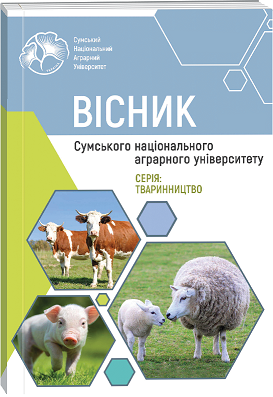PRODUCTIVITY OF YOUNG CLARIA CATFISH (CLARIAS GARIEPINUS) USING COMPOUND FEED WITH DIFFERENT LEVELS OF FERMENTED SOYBEAN MEAL EP500
Abstract
The article examines the impact of feeding compound feed with different levels of fishmeal substitution with fermented soy meal EP500 on the live weight and average daily growth of j uvenile clary catfish (Clarias gariepinus). Experimental research was carried out on the basis of the P.D. Pshenychnyy Department of Animal Nutrition and Feed Technology of the National University of Life and Environmental Sciences of Ukraine. A scientific and economic experiment was conducted using the method of groups of analogues lasting 56 days, which was divided into 4 subperiods of 14 days each. For the experiment, 600 heads of young clary catfish (Clarias gariepinus) with an average weight of 25 grams were selected and six groups of 100 heads each were formed according to the method of analogues – control and 5 experimental. Young clary catfish were fed with compound feed, which differed in levels of fermented soybean meal. Thus, the combined feed of the control group contained 36% fish meal without the addition of fermented soy meal EP500, while in the combined feed of group 2 the content of fish meal was reduced to 26% and 10% fermented soy meal EP500 was added. In combined feed for group 3, the level of fish meal was continued to decrease to 21% and the level of fermented soybean meal EP500 was increased to 15%. Focusing on 100% replacement of fishmeal, compound feed of groups 4, 5 and 6 was characterized by 16%, 11% and 0% content of this ingredient, while fermented soybean meal EP500 in these groups was 20, 25 and 36%, respectively. Weighing on the 42nd day of the experiment showed that the young clary catfish of the second and third groups were ahead of the control in terms of live weight by 1.0% and 1.6%, respectively. The live weight of fish of the fourth group was significantly higher than the control by 2.2% (р≤0.05). The fifth and sixth groups were also significantly ahead of the control by 2.5 (p≤0.05) and 2.6% (p≤0.05), respectively. The final weighing on day 56 of the study showed the superiority of the fourth, fifth and sixth experimental groups. The live weight of fish of these groups was significantly higher than the control by 3.1% (р≤0.05) in the fourth group, by 3.5% (р≤0.05) in the fifth and by 3.9% higher in the sixth group (p≤0.01). The analysis of average daily growth over the entire growing period showed a probable difference in this indicator in the fish of the fourth experimental group, which exceeded the control by 3.6% (р≤0.05). Average daily growth in the fifth and sixth experimental groups was also significantly higher than the control group by 3.9% (р≤0.01) and 4.3% (р≤0.01), respectively.
References
2. Food and Agriculture Organization of the United Nations. (2014). State of world fisheries and aquaculture 2014: Opportunities and challenges. Food & Agriculture Organization of the United Nations.
3. Fuentes-Quesada, J. P., Viana, M. T., Rombenso, A. N., Guerrero-Rentería, Y., Nomura-Solís, M., Gomez-Calle, V., Lazo, J. P., & Mata-Sotres, J. A. (2018). Enteritis induction by soybean meal in Totoaba macdonaldi diets: Effects on growth performance, digestive capacity, immune response and distal intestine integrity. Aquaculture, 495, 78–89. https://doi. org/10.1016/j.aquaculture.2018.05.025
4. He, M., Yu, Y., Li, X., Poolsawat, L., Yang, P., Bian, Y., Guo, Z., & Leng, X. (2020). An evaluation of replacing fish meal with fermented soybean meal in the diets of largemouth bass ( Micropterus salmoides ): Growth, nutrition utilization and intestinal histology. Aquaculture Research, 51(10), 4302–4314. https://doi.org/10.1111/are.14774
5. Hossain, S., Koshio, S., Ishikawa, M., Yokoyama, S., Sony, N. M., Islam, J., Maekawa, M., & Fujieda, T. (2018). Substitution of dietary fishmeal by soybean meal with inosine administration influences growth, digestibility, immunity, stress resistance and gut morphology of juvenile amberjack Seriola dumerili. Aquaculture, 488, 174–188. https://doi.org/10.1016/j. aquaculture.2018.01.037
6. Lilleeng, E., Frøystad, M. K., Vekterud, K., Valen, E. C., & Krogdahl, Å. (2007). Comparison of intestinal gene expression in Atlantic cod (Gadus morhua) fed standard fish meal or soybean meal by means of suppression subtractive hybridization and real-time PCR. Aquaculture, 267(1-4), 269–283. https://doi.org/10.1016/ j.aquaculture.2007.01.048
7. National Research Council (U.S.). Committee on the Nutrient Requirements of Fish and Shrimp. (2011). Nutrient requirements of fish and shrimp. National Academies Press.
8. Shiu, Y.-L., Hsieh, S.-L., Guei, W.-C., Tsai, Y.-T., Chiu, C.-H., & Liu, C.-H. (2013). UsingBacillus subtilisE20-fermented soybean meal as replacement for fish meal in the diet of orange-spotted grouper (Epinephelus coioides, Hamilton). Aquaculture Research, 46(6), 1403–1416. https://doi.org/10.1111/are.12294
9. The state of world fisheries and aquaculture 2022. (2022). FAO. https://doi.org/10.4060/cc0461en
10. Taher, S., Romano, N., Arshad, A., Ebrahimi, M., Teh, J. C., Ng, W.-K., & Kumar, V. (2017). Assessing the feasibility of dietary soybean meal replacement for fishmeal to the swimming crab, Portunus pelagicus, juveniles. Aquaculture, 469, 88–94. https://doi.org/10.1016/j.aquaculture.2016.11.036
11. Wang, L., Zhou, H., He, R., Xu, W., Mai, K., & He, G. (2016). Effects of soybean meal fermentation by lactobacillus plantarum P8 on growth, immune responses, and intestinal morphology in juvenile turbot (scophthalmus maximus L.). Aquaculture, 464, 87–94. https://doi.org/10.1016/j.aquaculture.2016.06.026
12. Zakaria, M. K., Kari, Z. A., Van Doan, H., Kabir, M. A., Che Harun, H., Mohamad Sukri, S. A., Goh, K. W., Wee, W., Khoo, M. I., & Wei, L. S. (2022). Fermented soybean meal (FSBM) in african catfish (clarias gariepinus) diets: Effects on growth performance, fish gut microbiota analysis, blood haematology, and liver morphology. Life, 12(11), 1851. https://doi. org/10.3390/life12111851
13. Zhang, J.-X., Guo, L.-Y., Feng, L., Jiang, W.-D., Kuang, S.-Y., Liu, Y., Hu, K., Jiang, J., Li, S.-H., Tang, L., & Zhou, X.-Q. (2013). Soybean β-Conglycinin Induces Inflammation and Oxidation and Causes Dysfunction of Intestinal Digestion and Absorption in Fish. PLoS ONE, 8(3), Стаття e58115. https://doi.org/10.1371/journal.pone.0058115

 ISSN
ISSN  ISSN
ISSN 



